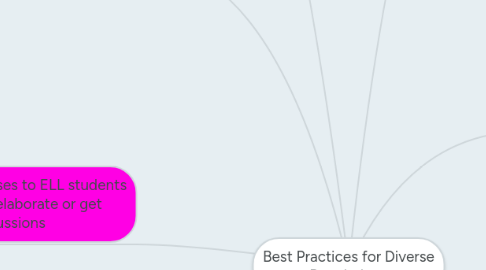Best Practices for Diverse Populations
by Mattea Meadows


1. "Stage Setting"
1.1. This is a great activity to precede any new concept that students will be learning and benefits all students, as it incorporates habits of effective readers, such as making connections and predicting. When I taught using the History Alive curriculum, there was always a preview activity that asked students to connect the new information we were about to learn to previous knowledge, either from their life experiences or previous chapters from the class. I think this could be modified a little bit to be more effective, such as allowing the students to work in small groups for this activity.
2. Call and Response
2.1. I love this idea and enjoyed learning that it is apart of the African-American culture. When reflecting on some situations in my classroom, I can see where this would be misunderstood as rudeness. However, I would like to encourage it in my classroom by providing a structured way for students to interact with the text as we read. I think I would do this by giving students a list of different verbal responses that they can have while we are reading a text. They may be something like "That was funny!" or "I'm confused!" or "Why would the character chose to do this instead of that?' I think it will also be important for me to acknowledge their response and use it to get other students engaged. This is a great example of how students can take ownership of their learning and truly lead the direction of class discussions! I cannot wait to try this in my classroom next year!
3. Teacher responses to ELL students that help them elaborate or get involved in discussions
3.1. To encourage discussion participation from ELL students, I need to be readily equipped with responses that encourage their participation. For example, I can have a notecard of different ways to respond to ELL learners based on their responses. Sometimes, they may respond in correct ways, but need to elaborate on what they are saying. Another way I may encourage their participation is by understanding their need to understand and validating that asking questions for understanding is the sign of a good learner. I plan to work with the ELL resource teacher at my school to build these responses in a way that makes my classroom a safe environment for my ELL students to be verbally active in conversations.
4. Model Proficient Oral Language
4.1. I plan to accept partial answers and try to look at the content of my ELL students' answers and work on modeling more complete sentences when I speak and respond. I once read somewhere that this is a good practice to use with toddlers as they construct words, as it does not focus on their wrong pronunciations, yet encourages correct language.
5. Make time for small talk in one-on-one interactions
5.1. This is one of my favorite things to do with ELL students! They are much more comfortable talking with me in a one-on-one or small-group setting. I did not even know one of my students could speak as much English as she could until I conversed with her one-on-one during a class change one time. I also shared how these conversations have helped me build trusting relationships with my students. The story I shared was about a student who told me about his bus always being late and how it caused those students to miss breakfast. Another way this type of interaction benefits my students is that it gives them opportunities to use their newly acquired language skills and social responses in a setting that it not as intimidating.
6. Setting high expectations for all learners
6.1. At my school next year, students will be grouped into mixed ability classrooms. I think this will really change the expectations that I have for students and the expectations they have for themselves. Some of my students that were placed in my lower class this past year did not challenge themselves to perform higher because they knew their class was not expected to perform on a higher level like my other classes, Even though mixed-ability grouping will help, I must cultivate an atmosphere in my classroom that sets high expectations for all students in order to build them up and challenge them to be their best by believing in them.
7. Map Key
7.1. Blue: "Children Who Struggle with Reading"
7.1.1. Red: "Discourse/Instructional Conversations: Connecting School and Personal Discourses"
7.1.1.1. Pink: Reading Rockets Article
7.1.1.1.1. Yellow: "Children Who Struggle with Reading" and "Family Literacy in a Cultural Context"
